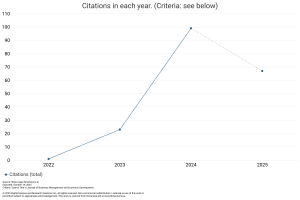Financial Ratios, Capital Structure, and EVA Impact on IDX Food and Beverage Manufacturers 2019-2021 Performance
DOI:
https://doi.org/10.59653/jbmed.v2i01.400Keywords:
financial ratio, capital structure, economic value added (EVA), financial performanceAbstract
This study examines how financial ratios, capital structure, and economic value added (EVA) affect Indonesia Stock Exchange-listed food and beverage manufacturers' financial performance. The study examined 14 companies as a sample and used financial statements from the Indonesia Stock Exchange website as secondary data. Descriptive statistical tests, classical assumption tests, multiple linear analysis, and hypothesis tests using t, F, and determination coefficient tests are some ways that data can be analyzed. The study found that financial ratio negatively affects the financial performance of Indonesia Stock Exchange-listed food and beverage companies (t count -2.943 < t table 2.024, significance values 0.006 < 0.05). Capital structure variables do not significantly affect financial performance for Stock Exchange-listed food and beverage manufacturing companies (t-calculus 0.728 < t-table 2.024, significance values 0.471 > 0.05). Economic value added (Eva) doesn't significantly affect companies that make food and drinks listed on the Indonesia Stock Exchange, as shown by t count -1.217 < t table 2.024 and significance value 0.231 > 0.05. Food and drink companies listed on the Indonesia Stock Exchange can make more money thanks to financial ratio, capital structure, and Eva. This is backed up by F count 4.096 > There are significance levels of 0.013 and 0.05 in F table 3.24. The independent variable in this study explains 18.5% of the company's financial performance.
Downloads
References
Cahyandari, A., Yusuf, H. F., &; Rachmawati, L. (2021). Analysis of Economic Value Added (Eva), Financial Value Added (Fva) and Market Value Added (MVA) as a measure of financial performance. JIAI (Indonesian Scientific Journal of Accounting), 6(2). https://doi.org/10.32528/jiai.v6i2.5713
Carolina, J., &; L. Tobing, V. C. (2019). The effect of profitability, liquidity, solvency and company size on the timeliness of financial statement submission in manufacturing companies on the IDX. Barelang Accounting Journal, 3(2), 45–54. https://doi.org/10.33884/jab.v3i2.1258
Cashmere. (2019). Financial Statement Analysis.
Damayanti. (2021a). The Effect of Intellectual Capital (IC), Market Value Added (MVA), Economic Value Added (EVA), and Debt to Equity Ratio (DER) on Financial Performance (Study on Food and Beverage Sub-Sector Manufacturing Companies Listed on the Indonesia Stock Exchange Tahu.ic.
Damayanti, R. (2021b). Financial Performance Analysis Using Economic Value Added (EVA) Method at PT Telekomunikasi Indonesia (Persero) Tbk, on the Indonesia Stock Exchange. Makassar State University. http://eprints.unm.ac.id/21033/
DEWIKA, Y. R. (2019). The effect of capital structure on financial performance of telecommunication companies on the Indonesia Stock Exchange. ISSN 2502-3632 (Online) ISSN 2356-0304 (Paper) International & National Online Journal Vol. 7 No.1, January – June 2019 University of 17 August 1945 Jakarta, 53(9), 1689–1699.
Hendry, R. S. M. (2019). Analysis of factors affecting the dividend payout ratio of manufacturing companies listed on the IDX. Ecobisma (Journal of Economics, Business and Management), 2(1), 1–11. https://doi.org/10.36987/ecobi.v2i1.57
Nerew, I., Zuhroh, D., &; Harmono. (2021). Diamond Theory Fraud Analysis in Detecting Financial Statement Fraud. Journal of Accounting Science and Research, 8(2), 317– 342.
Niki, K. (2020). Financial performance analysis is reviewed from the Economics Value Added (EVA) and Market Value Added (MVA) approaches of PT. PT. Rajawali Nusantara Indonesia (Persero). Economic Image, 1(1)(1), 1–10. http://www.jurnal-citra-ekonomi.com/index.php/jurnalci/article/view/25
Purnomo, E., Sriwidodo, U., Wibowo, E., Studi, P., Faculties, M., University, E., &; Riyadi, S. (2016). The effect of financial ratios on financial performance in national foreign exchange private commercial banks listed on the Indonesia Stock Exchange for the period 2013 – 2016. 189–198.
Sugiyono. (2021). The Effect of Price Earning (Per), Earning Per Share (Eps), Debt To Equity Ratio (Der) Against Sugiyono. 2021. "The Effect of Price Earning (Per), Earning Per Share (Eps), Debt To Equity Ratio (Der) On Share Price." Management and Business 1(1):40–57.Price only. Management and Business, 1(1), 40–57. https://www.journal.moestopo.ac.id/index.php/jmb/article/download/1338/654
Sugiyono, P. D. (2019). QUANTITATIVE RESEARCH METHODS OF SKIN and R &D (M. Dr. Ir. Sutopo. D.Pd (ed.); Kedu Edition). ALFABETA, cv.
Suryani, E., Economics, F., & Telkom, U. (2018). CAPITAL STRUCTURE, LIQUIDITY, AND COMPANY SIZE. 10(2), 74–79.
Wicaksono, D. (2021). The Effect of Profitability, Institutional Ownership, and Company Size on the Timeliness of Financial Statement Submission (Empirical Study on Consumer Goods Industry Sector Companies listed on the Indonesia Stock Exchange for the period 2014-2018). PERFORMANCE Journal of Economics and Business, 3(2), 183–197.
Wijayanto, R. (2021). Analysis of Financial Performance of Food and Beverage Companies Listed on the Indonesia Stock Exchange for the 2017-2019 Period. 1–42. http://repository.ummat.ac.id/2331/1/COVER-CHAPTERIII.pdf
Downloads
Published
How to Cite
Issue
Section
License
Copyright (c) 2023 Sri Handini

This work is licensed under a Creative Commons Attribution-ShareAlike 4.0 International License.
Authors who publish with this journal agree to the following terms:
- Authors retain copyright and grant the journal right of first publication with the work simultaneously licensed under a Creative Commons Attribution-ShareAlike that allows others to share the work with an acknowledgement of the work's authorship and initial publication in this journal.
- Authors are able to enter into separate, additional contractual arrangements for the non-exclusive distribution of the journal's published version of the work (e.g., post it to an institutional repository or publish it in a book), with an acknowledgement of its initial publication in this journal.
- Authors are permitted and encouraged to post their work online (e.g., in institutional repositories or on their website) prior to and during the submission process, as it can lead to productive exchanges, as well as earlier and greater citation of published work (See The Effect of Open Access).





























